
The ocelot is a medium-sized spotted wild cat that reaches 40–50 cm (16–20 in) at the shoulders and weighs between 7 and 15.5 kg on average. It is native to the southwestern United States, Mexico, Central and South America, and the Caribbean islands of Trinidad and Margarita. Carl Linnaeus scientifically described it in 1758. Two subspecies are recognized.
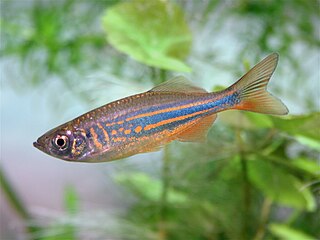
The giant danio is a tropical fish belonging to the minnow family Cyprinidae. Originating in Sri Lanka, Nepal, and the west coast of India, this species grows to a maximum length of 4–6 inches (10–15 cm), making it one of the largest of the danionins. It is characterized by a blue and yellow, torpedo-shaped body with gray and clear fins.
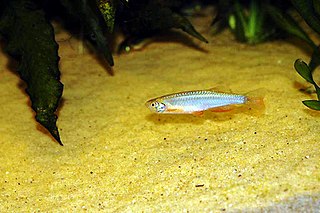
The pearl danio is a tropical fish belonging to the minnow family Cyprinidae. Originating in Sumatra, Myanmar, and Thailand and Vietnam ,this fish is sometimes found in aquariums by fish-keeping hobbyists. It grows to a maximum length of 2.6 inches (6.5 cm) and lives for around five years. The fish could have a brownish-yellow, pink, or a silver body and two light yellow/white or blue/red stripes. It has an iridescent look. The female fish has two pairs of barbels.
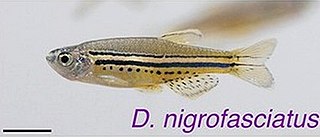
The spotted danio or dwarf danio is a tropical fish belonging to the minnow family (Cyprinidae). Originating in northern Myanmar, this fish is sometimes found in community tanks by fish-keeping hobbyists. It grows to a maximum length of 1.5 inches to 1.6 inches.

The Bengal danio or Sind danio is a subtropical fish belonging to the minnow family (Cyprinidae). Originating in Pakistan, India, Nepal, Bangladesh, and Afghanistan, this fish is sometimes kept in community tanks by fish-keeping hobbyists. It grows to a maximum length of 4 in (10 cm).

The Malabar danio is a tropical fish belonging to the minnow family (Cyprinidae). Originating in Sri Lanka and the west coast of India, the fish has been circulated throughout the world through the aquarium fish trade. It grows to a maximum length of 6 in (15 cm) but rarely exceeds 4 in (10 cm) in a home aquarium.
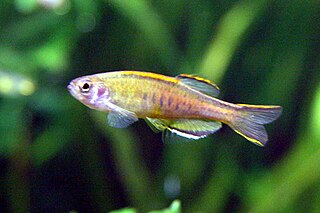
The glowlight danio is a small, schooling fish closely related to the popular zebrafish Danio rerio. This should not be confused with the GloFish, a trademarked brand of fluorescent zebrafish that appear to glow in the dark under ultraviolet light.
Danio dangila, the moustached danio, is a freshwater fish, and is the largest of the true Danio species at up to (6 in) long. Its name is from its particularly long barbels. It is sometimes kept in aquariums, where its relatively passive nature allows it to be housed in a community tank.
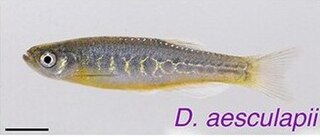
The panther danio is a species of danio endemic to Myanmar. Before its description it was referred to as Danio species TW03. The panther is a smallish danio which on first glance looks a little dull, but displays a variety of colours when sunlight illuminates the fish on its side.

The rose danio is a tropical fish of the family Cyprinidae. At first glance, this species resembles the pearl danio, but lacks the orange stripe on the side. It has a rosy colouration along the lower part of the fish and lower fins and gleams purple-blue in sunlight. It is also commonly known as the purple passion danio. Its natural range includes the Mekong River drainage in China, Thailand. Laos, and Myanmar.
The redfin danio is a fish. The redfin danio resembles a zebra danio with blood-red fins. It may be a colour morph of the orange-finned zebra danio, Danio quagga or Danio kyathit.
The blue moon danio is a species of cyprinid fish endemic to Myanmar. First described in 2009, they are found in small forested streams on the western slope of the Arakan Mountains in Rakhine State of south-western Myanmar; these streams are typically reduced to a series of interconnected pools during the dry season. This species has also been imported to Europe as aquarium fishes with the code names “TW02” and “Broken Line”.
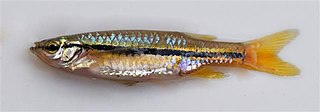
The Indian flying barb, historically flying barb, is one of the species known in the group flying barbs owing to their extremely long barbels. It was discovered as long ago as 1822 by Hamilton. However, it is rarely seen in aquaria. It is found in Myanmar, Nepal, Pakistan, Sri Lanka and India, it is found in many of the same localities as Danio rerio and Danio dangila, an example being the Jorai Rivulet, a tributary of the Sankosh river in Coochbehar district, West Bengal, India. The rare fish Borellius spp. is locally named "Boirali maach". In Nepalese Terai it is called Dedhawa.

Danio margaritatus, the celestial pearl danio, often referred to in the aquarium trade as galaxy rasbora or Microrasbora sp. 'Galaxy', is a small cyprinid from Myanmar and Northern Thailand. It has so far been found only in a very small area near Hopong east of Inle Lake, at an elevation of over 1,000 m (3,400 ft). Its habitat is part of the Salween basin, namely the Nam Lang and Nam Pawn Rivers. Discovered in 2006, the species quickly appeared in the aquarium trade, where its small size and bright colours made it an instant hit.
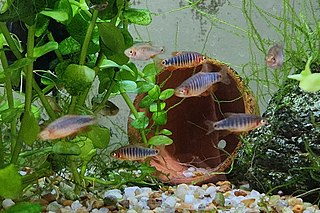
Danio erythromicron, often known as emerald dwarf danio and emerald dwarf rasbora, is a species of cyprinid fish which is endemic to Inle Lake in Myanmar.

The danionins are a group of small, minnow-type fish belonging to the family Cyprinidae. Species of this group are in the genera clades Danio and Devario, based on the latest phylo-genetic research by Fang et al in 2009. They are primarily native to the fresh waters of South and Southeast Asia, with fewer species in Africa. Many species are brightly coloured and are available as aquarium fish worldwide. Fishes of the danio clade tend to have horizontal stripes, rows of spots, or vertical bars, and often have long barbels. Species within the devario clade tend to have vertical or horizontal bars, and short, rudimentary barbels, if present at all. All danionins are egg scatterers, and breed in the rainy season in the wild. They are carnivores, living on insects and small crustaceans.
Danio jaintianensis is a species of Danio endemic to India.
Fang Fang Kullander, née Fang Fang, was a Swedish-Chinese ichthyologist.















